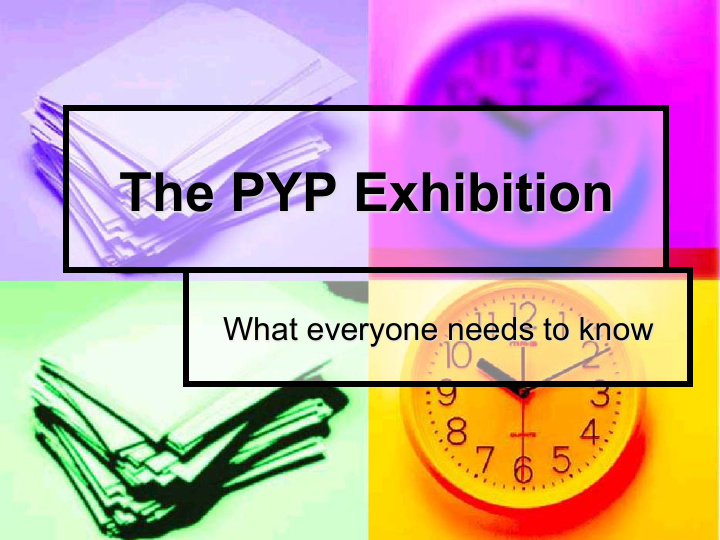



The PYP Exhibition What everyone needs to know
Wha hat i is i it? A showcase of student learners A collaboration of work by students It addresses real life issues It gives students a chance to take action It encourages students to take responsibility for their own education A celebration of their time in the PYP A transition into students’ higher education
Non ne n negotiable le f features… The subject of the inquiry must be a real world issue. Students MUST be involved in all stages of planning: the central idea and lines of inquiry Ø the learning outcomes Ø the activities Ø the assessment. Ø The Exhibition should include: examples of written work Ø oral presentations Ø process displays Ø performances in any medium – dance, drama, film, video, mixed Ø media.
Non ne n negotiable le f features c cont ntinu nued… Students must show an understanding of the key concepts : form, function, causation, change, connection, perspective, responsibility, reflection. Students must use transdisciplinary skills from all 5 areas: social, research, self management, communication, thinking. Students must show and reflect on the learner profiles, being; a thinker, reflective, balanced, principled, a communicator, open-minded, an inquirer, caring. Students must show positive learner attitudes ; appreciation, commitment, confidence, cooperation, creativity, curiosity, empathy, enthusiasm, independence, integrity, respect, tolerance.
The he R Role les Mentor Student and Group Teacher Parents
Our A Approach t h to E Exhi hibition • students choose a topic which they feel passionate and concern from any transdisciplinary theme • design the central idea and lines of inquiry for your topic (Key Concepts) • Participate in a whole class performance that celebrate the common themes of everyone’s work
How c can p n parent nts he help lp? Parents can: keep informed about the process by reading newsletters and attending meetings support and encourage their children provide knowledge or areas of expertise to any of the groups (if requested) help to locate resources – people, places, media and information be mentors celebrate with their child’s learning by attending the final the Exhibition.
How d do w we ma mark s k student nts w work? k? “Exhibitions are the best way to measure learning because they put the kids right in the midst of their learning” -Dennis Littky We assess the process more than the product. The students should keep a journal throughout exhibition that shows how their thinking and goals have developed. This journal may include pictures, diagrams, poems, timelines and writing. The mentors keep a record of group meetings, discussions, ideas, goals and progress.
Assessme ment nt There will be a variety of assessment areas, each covering a different aspect of the Exhibition. These will be conducted throughout the entire exhibition journey and include formative and summative assessments of: the Transdisciplinary Skills the Learner Profiles and Attitudes the Inquiry Process the student journals video journals the final product effort and participation
Who ho w will ma ll mark t k the he w work? k? students will self-assess and peer-assess using collaboratively designed assessment criteria. the class teacher will also use the criteria to assess. students will reflect throughout the entire exhibition journey. Parents and the community will reflect on the student’s work
Questions ns? Please feel free to ask any questions. THANK YOU FOR ATTENDING.
Recommend
More recommend